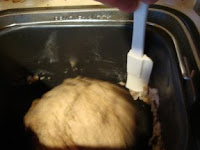In the 10 days since I last posted, I taught a workshop, finished pieces for a show, went downstate to help hang it, and got home to a cold house. The commercial water heater that runs our hydronic heat system needs to have a part replaced. So we fired up the wood stove and rearranged plans. We'll stay close to home to keep the fire stoked until the part comes in. We can drain the pipes easily enough, but would still worry about damage to the washing machine and dishwasher from freezing if there's no heat when the temperature dips as low as is predicted.
As my mother says, things have a way of working out for the best. We're home snug and safe. And while I'd love a hot shower, it's not that hard to heat water for sponge baths and washing dishes. In fact, it slows me down in a way that's good after the pace of the last few weeks.
So I'm finally getting the bread recipe I promised posted. We like hearty, whole grain bread, chewy bread that sticks to your ribs. Next time I'm in town, I'll take pictures of the flour grinder at Natural Living and you'll see one of the reasons I think our bread is pretty good. Other people seem to like it, too, when I take homemade bread or rolls or focaccia to potlucks. Homemade bread fits our budget better than good bread from the store, and it's pretty simple to make. Especially with the breadmaker. When our first bread machine wore out after about 10 years, it took me about 24 hours to buy a new one. When this one wears out (it's about seven years old), I'll probably replace it just as quickly.
It took me by surprise when recipes I used with the old machine didn't work exactly the same with the new one. I was frustrated at first, but it turned out to be a good thing. It got me over the notion that bread making is an exact science requiring precise measurement. You really won't go wrong just following the instructions in the manual that comes with a machine. But their recipes usually produce bread that's fluffier than we like. So here's how I break the rules.
First, while we use 100% whole wheat flour, we don't use the whole wheat setting on the machine. We use the basic (white bread) setting with the color (baking time) on "light." In this machine, I usually have to scrape down the sides with a rubber spatula while it's mixing to make sure all the good stuff gets incorporated.
Also, I adjust the moisture once the bread starts to knead. I'd rather keep our bread dense and chewy with a bit less water to begin with. If it seems too dry, I may add a teaspoon of warm water to the pan.
Don't be afraid to play with your bread machine recipes, or with mine, for that matter. Flours can vary a lot in how much moisture they absorb. Trust your eyes, your nose and your instincts. And be ready to pass the butter.
Donna's Everyday Bread (2 pound loaf)
1-2/3 cup warm water (test the temp on your wrist)
1 tsp. salt
2 (scant) Tbsp. dark brown sugar
2 Tbsp. olive oil
4 cups 100% whole wheat bread flour
2 Tbsp. milled flax seed
2 Tbsp. raw sunflower seeds
2 Tbsp. poppy seeds
2 Tbsp. millet
1-1/4 tsp. bread yeast
Follow your machine's instructions for the order in which to add liquids, dry ingredients and yeast. I add all the seeds with the flour (instead of waiting for the beep that signals "add ingredients"). Turn the machine on and let it mix, making adjustments to the moisture as necessary. When the baking cycle has finished, remove the bread from the baking pan promptly to a cooling rack. When cool, wrap it up for an hour or so before slicing if you want thinner slices. Or serve it warm in thick slabs with lots of butter, and start another loaf.


1 comment:
Donna, I also make pizza dough in my breadmaker. I'm allergic to tomatoes, so can't eat regular pizza, so I make our own most of the time. Very easy to do after you work out the changes to the recipe the breadmaker gives you--much, much healthier than anything you can buy.
Post a Comment